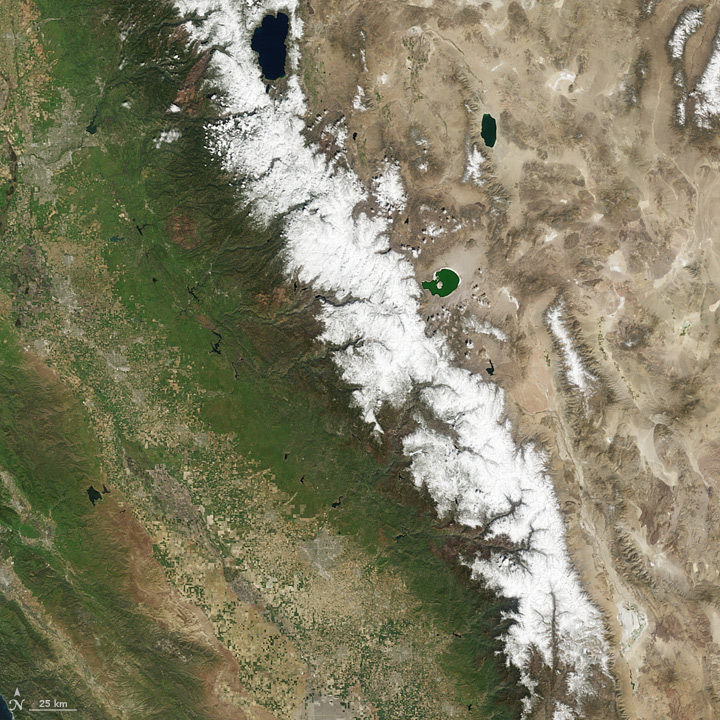Sea-spray aerosols change atmospheric river precipitation in mountains
Submitter
Fan, Jiwen — Pacific Northwest National Laboratory
Area of Research
Aerosol Properties
Journal Reference
Lin Y, J Fan, P DeMott, L Goldberger, J Comstock, Y Liu, J Jeong, and J Tomlinson. 2022. "Modeling impacts of ice-nucleating particles from marine aerosols on mixed-phase orographic clouds during 2015 ACAPEX field campaign." Atmospheric Chemistry and Physics, 22(10), 10.5194/acp-22-6749-2022.
Science

Figure 1. The Sierra Nevada snowpack is affected by marine sea-spray aerosols on the U.S. west coast. (Image by Jesse Allen|National Aeronautics and Space Administration.)
Understanding the factors that influence the precipitation (rain or snow) associated with atmospheric river (AR) events is important for developing a full picture of the hydrological processes and water resources in the western United States. Aerosol particles are one factor, but their specific effects are not well understood. Researchers performed a detailed modeling study of how marine sea-spray aerosols transported by ARs can affect winter storm precipitation. They found that the marine sea-spray aerosols enhance ice and snow formation by acting as ice-nucleating particles (INPs). This leads to fewer shallow warm clouds but more mixed-phase and deep clouds, resulting in more snow precipitation on the lee side of the mountains. The effects vary throughout AR stages, with the greatest difference in earlier stages.
Impact
Changes in the form (rain or snow) and location of precipitation have implications for regional hydrology and water availability. How marine aerosols alter where and how precipitation falls has not been substantially studied and is not considered in weather forecast models. This study fills that gap and provides a fundamental understanding of the impacts of marine INPs on precipitation in mountain regions associated with ARs. It suggests that weather and climate models need to consider the effects of marine INPs to reduce the forecast biases in precipitation.
Summary
Researchers explored the effects of marine aerosols on orographic (mountain-associated) mixed-phase clouds and precipitation at different AR stages. They examined an AR event observed during the 2015 Atmospheric Radiation Measurement user facility's Cloud-Aerosol-Precipitation Experiment (ACAPEX) field campaign under low dust (< 0.02 cm-3) conditions. They conducted simulations for the AR event with the chemistry version of the Weather Research and Forecasting model coupled with detailed bin microphysics at 1-km grid spacing, including ice nucleation connected with dust and marine aerosols. Compared against airborne and ground-based observations, accounting for marine INP effects improves the simulation of AR precipitation. The marine INPs enhance the formation of ice and snow, leading to fewer shallow warm clouds, more mixed-phase and deep clouds, and more snow precipitation on the lee side of the mountains. The response of the clouds and precipitation to marine INPs varies throughout the AR stages, with more significant effects in earlier stages. This is mainly because moisture and temperature conditions change with the AR evolution. This study provides a fundamental understanding of how marine INPs affect orographic precipitation associated with ARs, suggesting that weather and climate models need to consider the effects of marine INPs.
Keep up with the Atmospheric Observer
Updates on ARM news, events, and opportunities delivered to your inbox
ARM User Profile
ARM welcomes users from all institutions and nations. A free ARM user account is needed to access ARM data.


















